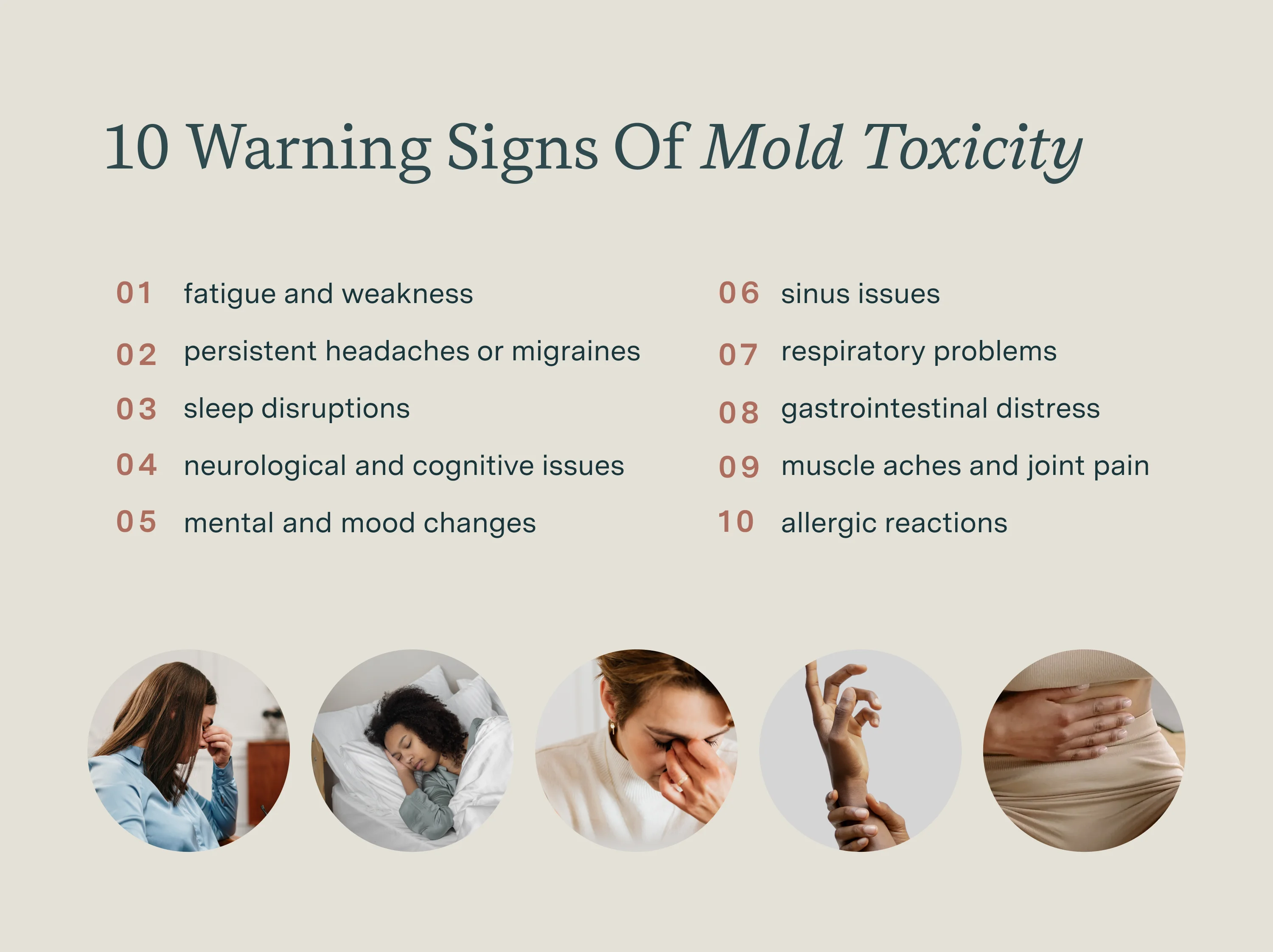Molds are ubiquitous in the environment and there’s no way to avoid being exposed to them. Most of the time they just go about their business, recycling vegetative matter and playing their part in the circle of life. Sometimes, though, they settle into a damp spot and start growing, presenting a danger to human health. In this article we’ll look at what molds and mold toxins are, what kind of symptoms mold toxicity can cause, what mold has to do with autoimmunity, and how to prevent and recover from mold toxicity.
What Is Mold?
Molds are fungi that grow both outdoors and indoors — they thrive in damp, warm, and humid environments, but are found virtually everywhere. Mold plays a vital role in our ecosystem, from digesting and breaking down organic material like fallen trees and dead leaves, to creating antibiotics such as penicillin. (Source, Source)
Molds are different from some other kinds of fungi in that their cells grow and fuse together, forming a network of tiny threads called filaments. Molds reproduce through the production of microscopic spores, which are similar to plant seeds and can be easily carried great distances by the wind.
The spore count in the air varies seasonally, daily, and even hourly. These spores are a constant presence in indoor environments as well, and while they won't grow without moisture, they can cause significant structural and cosmetic damage to buildings and furnishings if they land on a wet or damp spot and start growing. When spores from mold are released into the air, they can also be inhaled, swallowed, or come into contact with the skin. (Source, Source, Source)
What Is Mold Toxicity?
Many different types of molds can produce mycotoxins, which are toxic compounds that can lead to a range of health issues. Mold toxicity, also known as mycotoxicosis, is a health condition caused by exposure to these mycotoxins. The severity of the effects of mycotoxins varies based on the type and duration of mold exposure, the specific mycotoxins involved, and the individual's health status. (Source, Source)

10 Warning Signs Of Mold Toxicity
Recognizing the symptoms of mold toxicity is crucial for early detection and treatment, as prolonged exposure to mold can cause a multitude of health issues, some of which can be serious if not addressed promptly. The symptoms can vary between individuals, but there are 10 common warning signs to watch out for.
1. Fatigue and Weakness
If you feel fatigued or weak on a regular basis, it could indicate mold toxicity. Mold spores can deposit in the nasal passages and move into the lungs causing pneumonia, which reduces oxygen intake, leading to frequent fatigue and weakness. Mycotoxins are known to impair mitochondrial function and increase oxidative damage, contributing to fatigue. (Source, Source, Source)
2. Persistent Headaches or Migraines
Frequent headaches or migraines can be a sign of mold toxicity. Exposure to mold and subsequent immune response can lead to headaches, which may subside upon leaving a mold-infested environment. (Source, Source)

3. Sleep Disruptions
Mold toxicity can lead to insomnia, including trouble falling asleep, waking throughout the night, and a decrease in the total amount of time asleep. (Source, Source)
4. Neurological and Cognitive Issues
Prolonged exposure to mycotoxins can affect your nervous system and lead to issues such as memory loss, confusion, and impaired balance, or to even more severe problems such as neuropathy, dementia, and lower cognitive and neuropsychological function. (Source, Source, Source, Source)
5. Mental and Mood Changes
Changes in mood, including depression and anxiety, could be due to the effect of mold on the brain’s neurotransmitter functions. Mycotoxins are believed to disrupt normal brain processes and affect the production of neurotransmitters such as dopamine and serotonin, leading to mood imbalances. (Source, Source, Source)
6. Sinus Issues
Nasal and sinus congestion are common signs of mold exposure. Additionally, you may experience allergic fungal sinusitis when exposed to mold. You may even be able to smell the damp, moldy odor of an indoor mold problem. (Source, Source)
7. Respiratory Problems
Mold spores can trigger asthma and asthma attacks, especially in people with mold allergies or existing respiratory conditions. Exposure to mold and mycotoxins has also been shown to cause or exacerbate conditions such as bronchitis and hypersensitivity pneumonitis, a rare immune disorder that causes lung inflammation. (Source, Source, Source)
8. Gastrointestinal Distress
The mycotoxins that molds produce, when inhaled or ingested, can irritate the digestive system. Many mycotoxins have been shown to negatively alter the gut microbiome and impair the function of the intestinal barrier. This can lead to symptoms such as nausea, abdominal pain, vomiting, intestinal bleeding, or diarrhea, as well as decreased nutrient absorption. Changes in appetite and weight may also occur. (Source, Source, Source)

.svg)
.png)
















.png)

 (1).webp)









 (1).jpeg)

.webp)
.webp)

.webp)

 (2).webp)

%201 (1).webp)

 2 (1).webp)




.svg)
.svg)